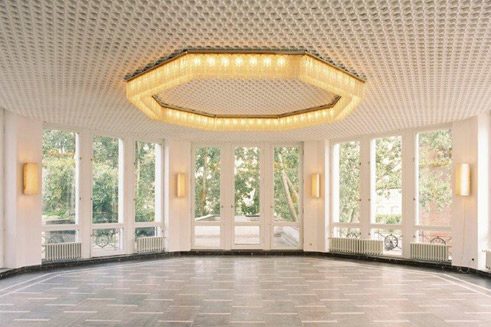The Schinkel Pavilion in Berlin-Mitte is perhaps Germany’s most unconventional art association. Where GDR nomenklatura once held cocktail parties, now Douglas Gordon, Cyprien Gaillard and Isa Genzken hold exhibitions.
The ambitious programme is not the only reason for the attraction the Schinkel pavilion holds for artists and the public since its first exhibition in 2007. The exceptional architecture and history of the location also play an important part. The Pavilion, built in 1969, is an extravagant mix of late-classicism and GDR modernity: an octagonal building, glassed in all around, that offers a panoramic view of the rapid changes in Berlin’s historic centre. Construction cranes are turning next to the Television Tower, Berlin Cathedral and Friedrichswerder Church. A dummy made of foils advertises for the rebuilding of Karl Friedrich Schinkel’s academy of architecture, built in 1836 and destroyed in World War II that in the past was considered a precursor of modern architecture. New luxury flats are arising, and where just a few years ago, the Palace of the Republic still stood - an object of prestige of the GDR – the Berlin City Palace complete with baroque facade is being rebuilt.
Chandeliers in GDR design
The Pavilion stands in the garden of the Crown Prince’s Palace that, starting in 1919, housed the world’s first museum of contemporary art. The “Galerie der Lebenden” (i.e. gallery of the living) presented mainly works from the studios of the Expressionists – until the National Socialists closed the gallery and destroyed the paintings or sold them abroad.
In the late 1960’s, architect Richard Paulick reconstructed the palace, which had been damaged in the Second World War and expanded it with the now landmarked Garden Pavilion. The East Berlin city council used the glass rotunda for receptions until 1989, after reunification the building stood vacant until it was discovered for art. Part of the magic of the place is provided by chandeliers in GDR design and terra-cotta reliefs, rescued originals from Schinkel’s architecture academy.
Floral arrangements and steam-shovel ballet
Eva Wilson, director of the Schinkel Pavilion, likes the hybrid quality of this place, the mix of different styles and chronological levels: “The space is not unambiguously defined and therefore has an openness that offers exciting friction surfaces for all sorts of artistic positions.” Cyprien Gaillard, for instance, in a spectacular performance, had three steam shovels dance in the excavation pit next to the Pavilion. With
Höhere Gewalt (i.e. force majeure), Thomas Hirschhorn created a large-scale installation out of cardboard and cling film that simulated the collapse of the Pavilion’s ceiling with deceptive realism. And young, lesser-known artists also find a platform here. French artist Camille Henrot, for example, presented filigree floral arrangements that only at first glance looked harmless.
-
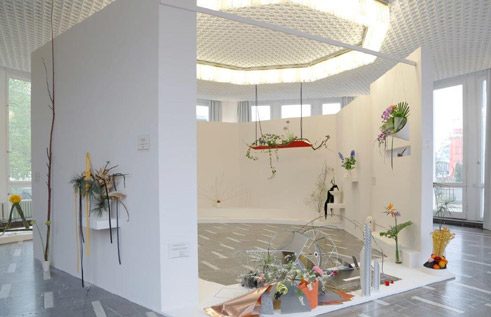 © Schinkel Pavillion
© Schinkel Pavillion
Camille Henrot, Snake Grass, April 2014 – Mai 2014
-
 © Schinkel Pavillion
© Schinkel Pavillion
Philippe Parreno, How Can We Tell the Dancers from the Dance, Nov 2014 – Febr 2015
-
 © Schinkel Pavillion
© Schinkel Pavillion
Douglas Gordon und Francesco Russo, a mimic, Februar 2015
-
 © Schinkel Pavillion
© Schinkel Pavillion
Thomas Hirschhorn, Höhere Gewalt, Installationsansicht, Aug – Sept 2014
-
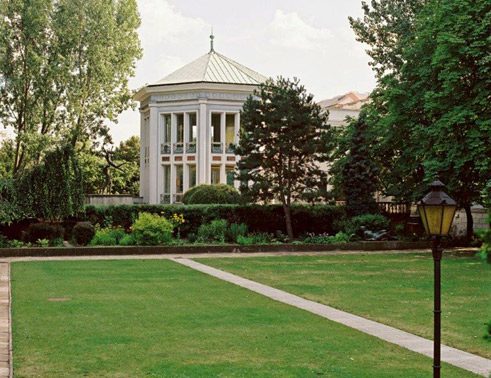 Foto (Ausschnitt): © Thorsten Klapsch
Foto (Ausschnitt): © Thorsten Klapsch
Schinkel Pavillion
-
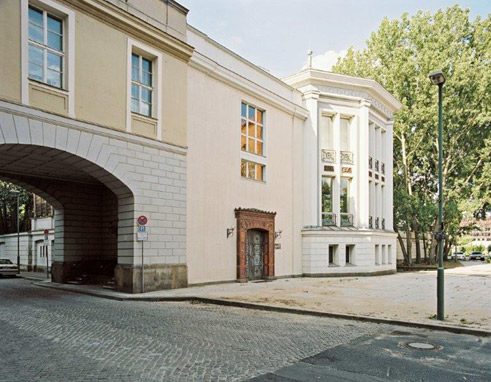 Foto (Ausschnitt): © Thorsten Klapsch
Foto (Ausschnitt): © Thorsten Klapsch
Schinkel Pavillion
-
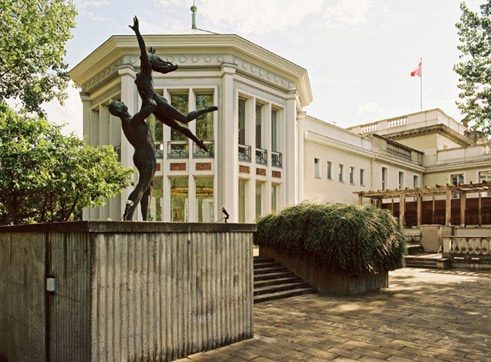 Foto (Ausschnitt): © Thorsten Klapsch
Foto (Ausschnitt): © Thorsten Klapsch
Schinkel Pavillion
-
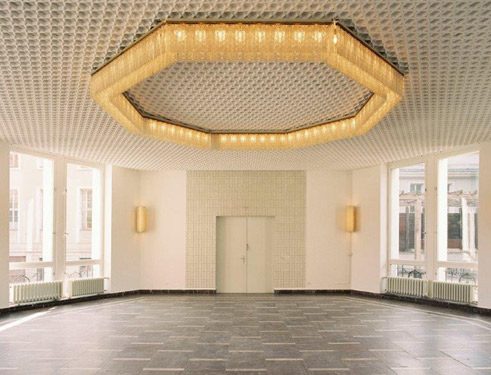 Foto (Ausschnitt): © Thorsten Klapsch
Foto (Ausschnitt): © Thorsten Klapsch
Schinkel Pavillion
-
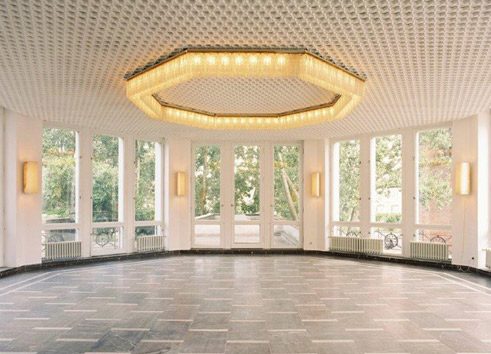 Foto (Ausschnitt): © Thorsten Klapsch
Foto (Ausschnitt): © Thorsten Klapsch
Schinkel Pavillion
“Our exhibition programme is supported by a strong international network based on friendship, collaborative work and passion for art,” says Eva Wilson. New forms of collaborative work are therefore a focal point of exhibition year 2015. The Schinkel Pavilion will be transformed from a showroom to an open space for work and production. Eva Wilson: “We don’t want to just place finished works in the Pavilion, but instead let them arise here before the eyes and ears of our visitors.”
A place of encounter
The director says that being able to respond independently and flexibly to current developments is a great advantage, even if a precarious status is a constant accompaniment. A long-term rental contract from the Federal Government, the actual owner of the Pavilion, does not exist. The exhibitions are financed by the art association members’ dues – an assessable sum – and project sponsorships. “Our goal is a basic financial security for a longer period of time,” thus Eva Wilson. A fundraiser in May will help; artists including Cindy Sherman and John Baldessari have already provided works.
With performances, installations, sculptures and media art, the Schinkel Pavilion is connecting with the tradition of the “Galerie der Lebenden” founded in the neighbouring Crown Prince’s Palace. Whether inspiring, amazing, disturbing or entertaining, the Schinkel Pavilion is an energy-charged venue of contemporary art – and much more than just a platform for discourse and concepts, as Eva Wilson says. “The Pavilion is also a place of encounter, people met, develop ideas together and exchange thoughts. It’s especially lovely in summer when we can use the terrace.”
